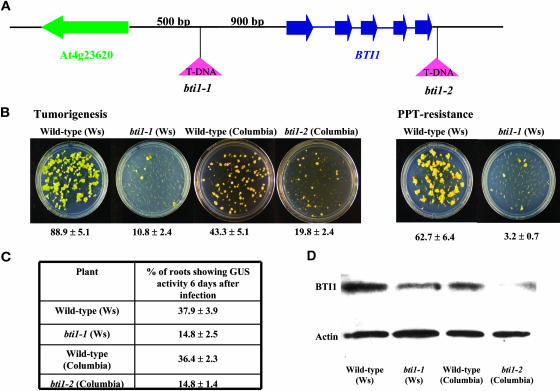Figure 8.
Arabidopsis Plants with T-DNA Insertions in BTI1 Show Reduced Levels of Agrobacterium-Mediated Root Transformation.
(A) Schematic representation of the region around the Arabidopsis BTI1 gene. In bti1-1 mutant plants, the T-DNA is inserted 900 bp before the start codon of the BTI1 gene. In bti1-2 mutant plants, the T-DNA is inserted 117 bp downstream of the BTI1 stop codon.
(B) bti1-1 and bti1-2 mutant plants are resistant to stable Agrobacterium-mediated root transformation. Representative plates of roots infected with Agrobacterium A208 (for tumorigenesis assays) and Agrobacterium At872 (for ppt-resistance assays) are shown. The numbers below each plate indicate average values of results from 20 individual plants ±se.
(C) bti1-1 and bti1-2 mutant plants show reduced susceptibility to transient transformation. Data are indicated as average values of results from 20 individual plants infected with Agrobacterium At849, ±se.
(D) bti1-1 and bti1-2 T-DNA–insertion mutant plants show reduced levels of BTI1 protein compared with wild-type plants. Proteins were extracted from roots and subjected to protein gel blot analysis as described in Methods. The amount of actin protein was used to show equivalent loading of each lane.

